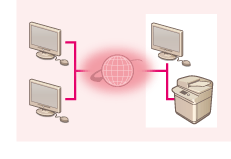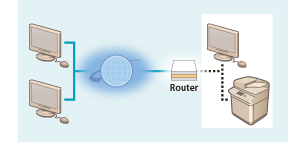
Preventing Unauthorized Access
This section describes preventive measures against unauthorized access from external networks. For administrators and users that are using the machine in a network environment, make sure to read this section before use. Connecting to networks enables you to use various functions such as printing, remote operation from a computer, sending scanned documents through the Internet, etc. However, for protection against unauthorized access from an external network, security measures are essential. This section describes some countermeasures against unauthorized access, which must be implemented before using the machine with a network environment.
Implementing Private IP Addresses
An IP address is a number that is assigned to a computer on a network. A "global IP address" is used for Internet connections. A "private IP address" is used for local area networks such as an office LAN. If your IP address is a global IP address, unauthorized users on the Internet can attempt to access your local network and risks such as information leakage become larger. If your address is a private address, only users on a local area network such as the office LAN have access.
 |  |
【Global IP address】 Accessible from outside your network | 【Private IP address】 Accessible only from within a local area network |
Generally, when setting up an IP address, use a private IP address. For a private IP address, any addresses in the following ranges can be used. Confirm if the IP address that is currently set is a private IP address.
Ranges of Private IP Addresses
10.0.0.0 to 10.255.255.255
172.16.0.0 to 172.31.255.255
192.168.0.0 to 192.168.255.255
For information on how to confirm IP addresses, see Setting an IPv4 Address.
 |
Even if a global IP address is set for the machine, risk of unauthorized access can be reduced by using a firewall. Consult your network administrator when you want to operate the machine using a global IP address. |
Limiting Communication via a Firewall
A firewall is a system that prevents unauthorized access from external networks in order to prevent attacks or invasion into the local area network. Access from outside your local network that has potential to be a risk can be shut out beforehand by limiting communication from a specific external IP address in your network environment. Restricting Communication by Using Firewalls
Setting up TLS Encryption Communication
For TLS communication, see Starting the Remote UI.
Managing the Machine's Information via Passwords
Even if the machine receives unauthorized access from a malicious third party, risk of information leakage can be greatly reduced when various information resources in the machine are protected by passwords.
Password for each function / PIN code setting
Personal authentication management using User Authentication Configuring the Personal Authentication Management Settings
PIN code setting for system management contents Changing the System Manager ID and PIN
PIN code settings for accessing Address Book Restricting Use of the Address Book
These are examples of preventing unauthorized access. For other details, see Managing the Machine and carry out necessary settings according to your environment.